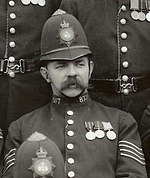Epsom Town railway station
1847 establishments in EnglandDisused railway stations in SurreyEpsomFormer London, Brighton and South Coast Railway stationsPages with no open date in Infobox station ... and 4 more
Railway stations in Great Britain closed in 1929Railway stations in Great Britain opened in 1847Transport in Epsom and EwellUse British English from November 2013

Epsom Town railway station is a closed railway station that served the town of Epsom in Surrey, England. For many years, Epsom had two railway stations, one built by the LSWR in 1859, and this station, built by the LBSCR twelve years earlier. It was located on Upper High Street and is less than ten minutes' walk from the town's other station. It closed in 1929 when the former LSWR station was rebuilt and expanded to four platforms.
Excerpt from the Wikipedia article Epsom Town railway station (License: CC BY-SA 3.0, Authors, Images).Epsom Town railway station
Prospect Place, Epsom and Ewell
Geographical coordinates (GPS) Address Nearby Places Show on map
Geographical coordinates (GPS)
| Latitude | Longitude |
|---|---|
| N 51.335 ° | E -0.261 ° |
Address
Prospect Place
KT17 1WW Epsom and Ewell
England, United Kingdom
Open on Google Maps









